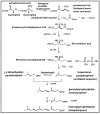Essential Oils' Chemical Characterization and Investigation of Some Biological Activities: A Critical Review
- PMID: 28930135
- PMCID: PMC5456241
- DOI: 10.3390/medicines3040025
Essential Oils' Chemical Characterization and Investigation of Some Biological Activities: A Critical Review
Abstract
This review covers literature data summarizing, on one hand, the chemistry of essential oils and, on the other hand, their most important activities. Essential oils, which are complex mixtures of volatile compounds particularly abundant in aromatic plants, are mainly composed of terpenes biogenerated by the mevalonate pathway. These volatile molecules include monoterpenes (hydrocarbon and oxygenated monoterpens), and also sesquiterpenes (hydrocarbon and oxygenated sesquiterpens). Furthermore, they contain phenolic compounds, which are derived via the shikimate pathway. Thanks to their chemical composition, essential oils possess numerous biological activities (antioxidant, anti-inflammatory, antimicrobial, etc…) of great interest in food and cosmetic industries, as well as in the human health field.
Keywords: biological activities; chemical composition; essential oils.
Conflict of interest statement
The authors declare no conflict of interest.
Figures
References
-
- Guenther E. The Essential Oils. D. Van Nostrand Company Inc.; New York, NY, USA: 1948. p. 427.
-
- Association Française de Normalisation (AFNOR) Huiles Essentielles, Tome 2, Monographies Relatives Aux Huiles Essentielles. 6th ed. AFNOR, Association Française de Normalisation; Paris, France: 2000.
-
- Carette Delacour A.S. Ph.D. Thesis. Université Lille 2; Lille, France: 2000. La Lavande et son Huile Essentielle.
-
- Sell C.S. The Chemistry of Fragrance. From Perfumer to Consumer. 2nd ed. The Royal Society of Chemistry; Cambridge, UK: 2006. p. 329.
Publication types
LinkOut - more resources
Full Text Sources
Other Literature Sources



